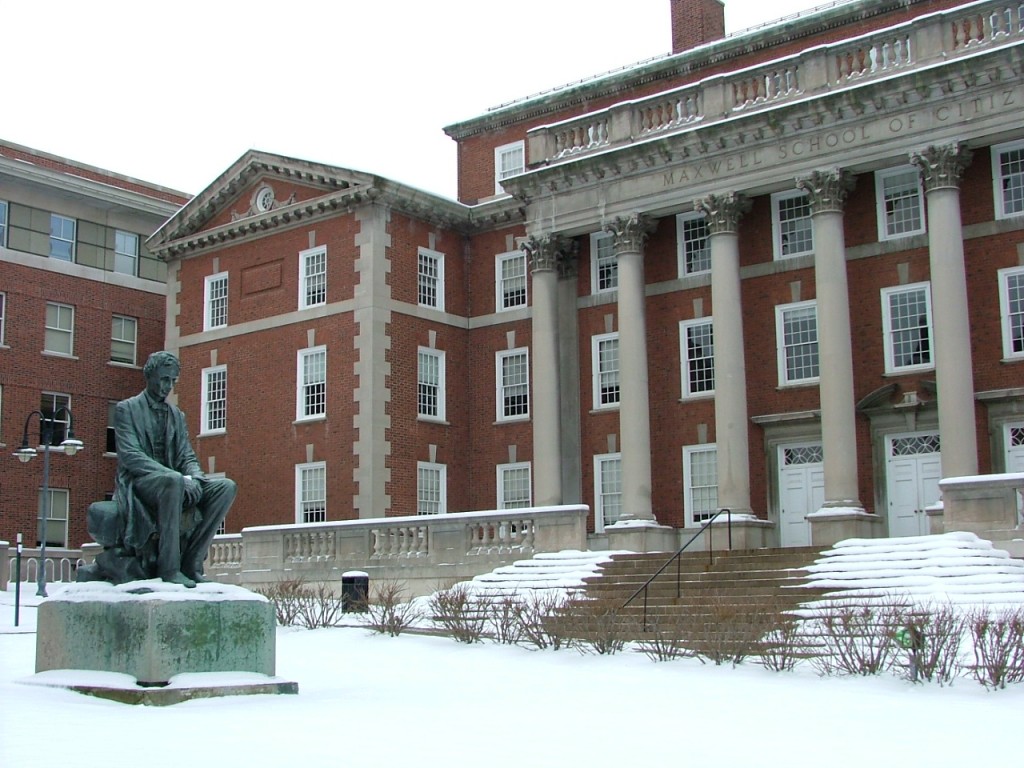
A unique concern of prospective students from warmer climate is the impending doom winter. Thanks to lake effect snow from Lake Ontario, Syracuse is America’s snowiest large city and has a lock on the Golden Snowball Award. Each year, an average 121.2 inches (308 cm) of the wicked white stuff falls upon students between November and April. For perspective, this blogger tops out at 69 inches (175 cm) tall!
What is a suntanned PAIA student to do? How will one get to school after it snows? How does one drive when the streets are covered? Trade a bicycle and a car for skis and a snowmobile? What about winter boots? And how many pairs of gloves, mittens, hats and scarves are required? Parka or pea coat? Snow blower or shovel? There are too many fears and concerns to list!
Start by relaxing. It is just snow, not nuclear fallout! Most snow storms are not large enough to impact people’s daily lives. After even a light dusting of snow, the streets are plowed and salted. Most of the sidewalks should be shoveled before the day is out. If either streets or sidewalks are not mostly clear before classes begin, school is usually canceled. Fortunately, Syracuse is used to dealing with snow and while students sleep, plow drivers clear the streets for the duration of the snow storm. While it takes an inch of snow to shut down Washington, D.C., it takes several feet to shut down Syracuse.
Students can spend a lot or a little on winter garb. If you plan to walk to school every day from Westcott or elsewhere, a good coat is essential. I recommend one which is waterproof because snow will often melt on your coat thanks to your body heat. A sale Columbia coat will probably function similar to a several hundred dollar NorthFace coat. Hats are helpful and occasionally fashionable although many women are at loath to mess up otherwise perfect hair with a hat. Earmuffs are a great alternative and some can even be worn with bike helmets. Gloves or mittens are often nicer than cold hands in pockets. Purchasing several pairs of both or either will not break the bank. There are even special gloves which allow users to operate a phone’s touch screen. Winter boots are important if you plan to walk because immediately after a storm, sidewalks may not be clear. As with a coat, waterproof winter boots are probably best because as the day warms, snow will become wet slush and form puddles usually wherever you need to walk. Talk to any current student or staff and they will add their own recommendations of specific stores or brands.
Driving in snow is not impossible and I actually enjoy it sometimes. You can pull doughnuts in parking lots by pulling up the parking brake! The key is to go slow and anticipate that things such as braking and acceleration will take longer. Do not expect your sports car to fly around corners with the same screech of tires from the summer! If you are freaked out about driving in snow, the only way to get better is to practice and after or even during a storm, try driving around the block a couple of times. Also, below are a few things to check in your car before the flurries fly.
- All-season or winter tires (most cars have the former) with a decent tread remaining (not bald!). You will not need snow chains.
- A plastic ice scraper to scrape snow and ice off a windshield.
- Windshield fluid because salt from roads gunk up windshields rather quickly. Many people carry an extra container in the trunk.
Ultimately, snow or weather in general should never be a deciding factor in selecting a school. Most of the time, you will be inside studying anyways. Plus, most students are here for no more than a year which is just one winter. With any luck, you will enjoy a few winter storms and know how to cope in another city of people who do not know how!